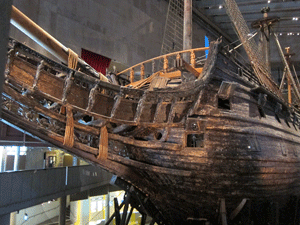As their focus shifts from
preservation to documentation,
researchers are learning new
lessons from the majestic Vasa— a
warship monumental in its
ambition, its failure, and its role in
maritime archaeology

The wreck of Vasa, a 17th-century Swedish warship,
now resides in a custom-built museum in Stockholm. Laser
surveys and digital models are helping determine why
the ship sank on its maiden voyage in 1628. (Courtesy Fred Hocker, Swedish National Maritime Museums)
The warship survived the first blast of wind
it encountered on its maiden voyage in Stockholm
Harbor. But the second gust did it in.
The sinking of Vasa, on August 10, 1628, took
place nowhere near an enemy. In fact, it sank
in full view of a horrified public, assembled to
see off their navy's—and Europe's—most ambitious warship to
date. The 220-foot, triple-deck, 64-gun leviathan, elaborately
adorned, had been rush-ordered for King Gustav Adolf's war
against Poland. But before it faced an opposing ship or fired a
single shot, Vasa slipped beneath the waves.
Gustav angrily demanded an inquest into why his expensive
new flagship lay at the bottom of the harbor. At the time,
investigators found several clues. Compared with previous
ships, Vasa had a thicker deck and held more and larger guns
on its upper deck, making it top-heavy. When it embarked,
Vasa carried almost none of the cargo and ballast that keep
ships low in the water and help them resist listing. And when
Vasa did list, open gun bays allowed the sea to rush in. The
inquest blamed the ship's proportions for the sinking, but
without modern blueprints or measuring techniques, investigators
offered few details. Still, Swedish shipbuilders appeared
to have learned from the experience: Vasa's subsequent sister
ships sailed without problems.
The cold, oxygen-poor water of the Baltic Sea protected
Vasa from the bacteria and worms that usually digest wooden wrecks. Perhaps 95 percent of Vasa's wood was intact when Sweden finally raised the wreck in 1961. The
ship's waterlogged wood could not support its own weight,
so experts crafted a steel cradle to hold the ship, first in a
temporary structure and then in a custom-built museum.
Despite the cradle, Vasa began a slow-motion collapse, and
preservationists scrambled to improve the cradle. They also
strengthened Vasa's wood by spraying it with polyethylene
glycol continuously for 17 years, followed by nine years of
drying. These challenges meant that, for decades, preservation
took precedence over archaeological investigations
into why the ship sank so suddenly. "Archaeologists had
their hands on the ship only in the initial excavation phase:
two months, for a 1,200-ton ship," says Kroum Batchvarov,
a marine archaeologist from the University of Connecticut
Avery Point, and a former student of Fred Hocker, who has
led the Vasa Museum's study of the ship since 2003.

To read more, find ARCHAEOLOGY in your local newsstand or bookstore, or click here to buy a copy of the issue online. And if you'd like to receive ARCHAEOLOGY in your mailbox, click here to subscribe.
Lucas Laursen is a science and technology journalist based in Madrid, Spain.

